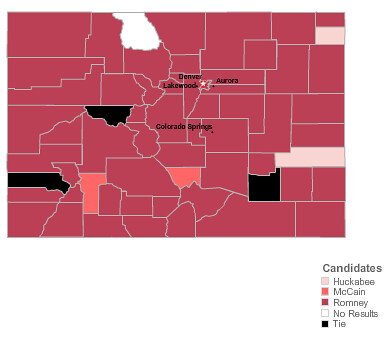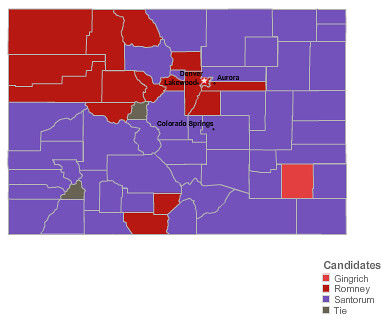It’s halftime in America. It’s halftime in the Republican primary, too. In Colorado and Minnesota, voters are caucusing and casting non-binding preference votes. In Missouri, they’re casting ballots in a three-way primary that Newt Gingrich chose not to spend the time qualifying for, because it doesn’t technically count.
Are you excited? I’m excited. Politico, which has to do this kind of thing, has been putting up some of the quicker results and stronger maps. Since the delegate hunt is only tangentially related to the results, you can watch for a benchmark instead. Will Romney out-perform or under-perform his 2008 numbers? In Colorado that year, Romney won 60 percent of the vote and 42,218 ballots. In Minnesota, he won 41 percent and 25,990 ballots.
And now, using the excuse of a primary in Minnesota to post a music video.
Live threading begins around 8 p.m.
8:20: We see the first wrinkle in public polling of Missouri’s show primary. PPP asked voters whether or not they backed Santorum, Romney, Paul, or “someone else.” In line-ups like that, assuming they have to choose someone, most voters make a call. But the actual ballot in Missouri included four options: Three candidates and uncommitted. There may well be Gingrich backers who go for the null option instead of defaulting for Santorum.
8:45: I’m watching the results at a party with a few other reporters and – in a bit of a surprise – some Republicans who have the night off. Why? Mostly, so far, so they can gawk bemusedly at CNN covering every single angle of contests that won’t produce delegates.
9:01: We sort of have results, from two Minnesota counties where more than 90 percent of the vote is in.
Roseau 2008:
Huckabee - 57%
Romney - 16%
McCain - 15%
Paul - 10%
Roseau 2012:
Santorum - 54%
Newt - 18%
Paul - 18%
Romney - 10%
And…
Traverse 2008:
Huckabee - 31%
Romney - 27%
McCain - 25%
Paul - 11%
Traverse 2012:
Santorum - 48%
Gingrich - 18%
Romney - 18%
Paul - 16%
These are not populous counties, but they reveal a dramatically smaller Romney vote – he’s no longer the “conservative” candidate against a moderate establishment choice, and no longer the guy who tried to out-organize in the states to make up for early weakness.
9:30: Santorum WINS the non-binding Missouri primary. Because it’s non-binding, CNN does not have exit polling of the results. Because CNN is a TV network, it blasts out a BREAKING NEWS chyron and assigns its pundits to discuss what the Missouri result means.
A primer: It doesn’t mean too much. Romney’s campaign made a call not to compete in Missouri, even though the candidate did quite well in 2008’s binding primary. The theory: Just as straw polls didn’t matter, non-binding primaries wouldn’t matter. This is partly true. They only matter as much as the media decides they do. But there’s another part of this – Santorum wasn’t destined to do so well. He capitalized on a native conservative vote.
10:05: There is a certain Casey-at-the-bat-ness about the Romney campaign. With full credit, I’ll borrow this chart from the Des Moines Register. The dark red indicates how many days candidates spent in Iowa. The light red indicates how many campaign events they held.
![]() One way of reading that: Romney won 1,569 votes for every day he spent in Iowa, and Santorum won 284 votes for every day he spent in Iowa. Advantage: Romney! But… why didn’t Romney spend a little more time in Iowa trying to lock it down. The simple answer is that the campaign held back as every other candidate fought for Iowa, then the Romney Super PAC Restore Our Future ran the ads it needed to crush Newt Gingrich. Still, what you got there was a strategy of avoidance (of town halls and of media availability, relative to the other candidates). It’s a minimalist strategy that will pay off as the candidate actually works to win Michigan and Arizona’s binding primaries. Maybe.
One way of reading that: Romney won 1,569 votes for every day he spent in Iowa, and Santorum won 284 votes for every day he spent in Iowa. Advantage: Romney! But… why didn’t Romney spend a little more time in Iowa trying to lock it down. The simple answer is that the campaign held back as every other candidate fought for Iowa, then the Romney Super PAC Restore Our Future ran the ads it needed to crush Newt Gingrich. Still, what you got there was a strategy of avoidance (of town halls and of media availability, relative to the other candidates). It’s a minimalist strategy that will pay off as the candidate actually works to win Michigan and Arizona’s binding primaries. Maybe.
10:30: The networks call Minnesota for Santorum, and indeed, Romney’s showing there is absolutely pathetic. In 2008 he won Minnesota win 25,990 votes, 41.4 percent of the total. He’s now so far behind Ron Paul that he’s probably guaranteed a third-place showing, possibly in the teens.
11:11: Let us turn away from the shiny, meaningless pie charts occupying our TV screens and ask: What happens next?
Well, the next binding delegate contests are on February 28: A primary in Michigan, and a primary in Arizona. The next debate is six days before that. Thanks to the “narrative,” Romney now has two strong conservative foes. It looks a little bit like 1996, when the contemporary surges of Steve Forbes and Pat Buchanan allowed Bob Dole to win his primaries.
That’s one possiblity. Perhaps the sleeping conservative donor base, the people who filled Sharron Angle’s accounts in 2010, will now discover Santorum. But it’s easier to solicit “STOP X NOW” donations than “Maybe stop the moderate presidential candidate from winning the primary” donations.
11:27: As much as I’m blowing off the Missouri primary, that Minnesota result stands out. The weak showing in Colorado – the state Romney actually decided to concentrate on – ain’t great either. I desparately asked a Romney source to spin me, and what I got was this: The campaign has as many delegates on Wednesday as it had on Tuesday. It’s focused on that. It opted not to spend time and money in these states.
12:58: The state party calls Colorado for Rick Santorum. Here’s how the state looked in 2008:
 Here’s how it looked tonight:
Here’s how it looked tonight:
 In 2008, when he was the Great Conservative hope against John McCain, Romney got 42,218 Colorado votes. This year: 23,097 votes, with a few more coming in. There are small armies of voters who weren’t reached out to, didn’t commit to Romney in the first place, and went to sleep on him.
In 2008, when he was the Great Conservative hope against John McCain, Romney got 42,218 Colorado votes. This year: 23,097 votes, with a few more coming in. There are small armies of voters who weren’t reached out to, didn’t commit to Romney in the first place, and went to sleep on him.
Neutered Tuesday: Open Election Results Thread
Advertisement